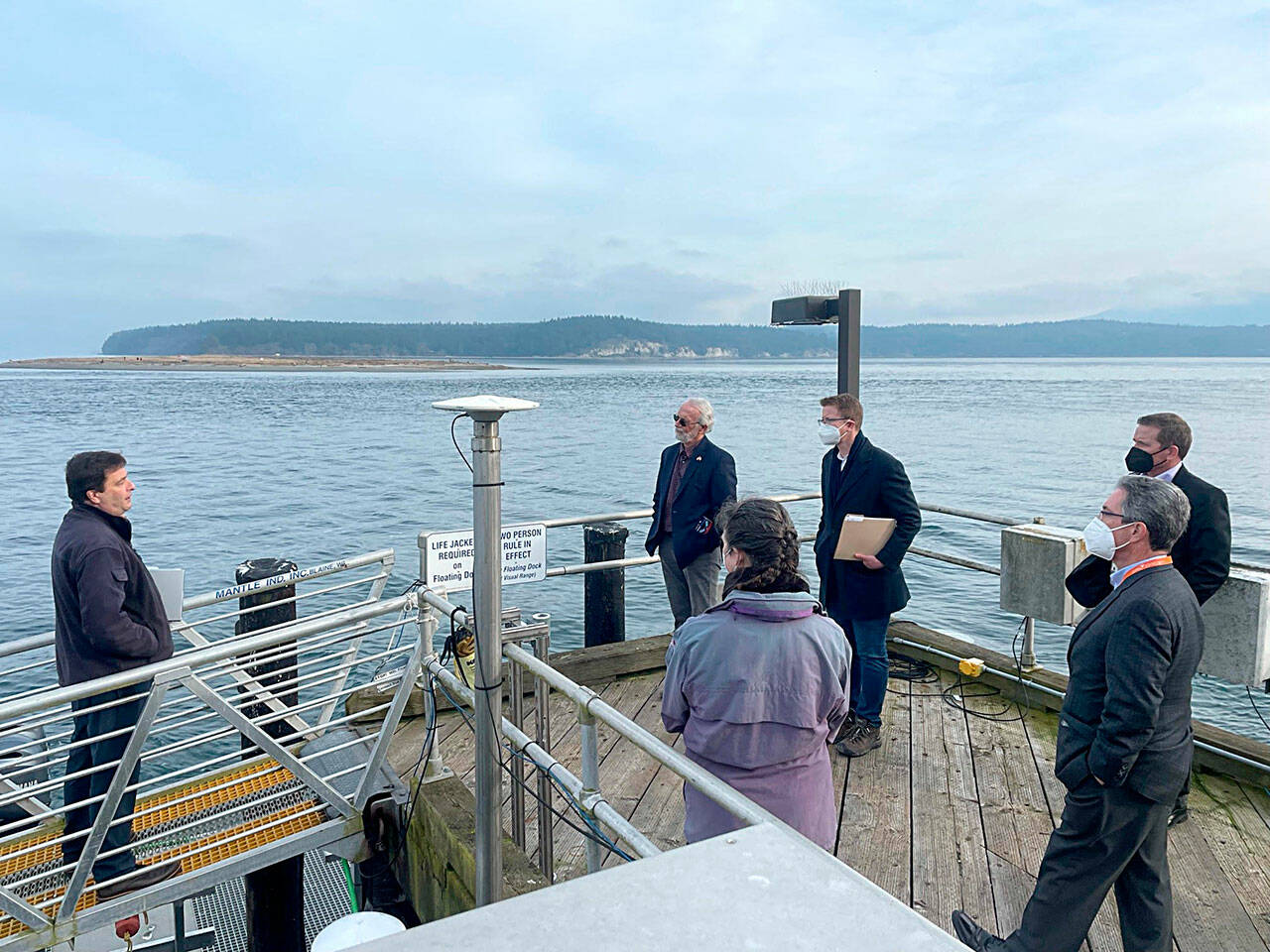A bipartisan bill from two Washington congressmen looks to increase efforts towards the state’s Blue Economy while potentially making Sequim the hub of that effort.
Representatives Derek Kilmer and Dan Newhouse on Jan. 28 toured Pacific Northwest National Laboratory’s Marine and Coastal Research Laboratory and talked about their plan to introduce the Blue Energy Innovation Act.
The bill proposes creating the Integrated Blue Economy and Blue Energy Technologies Program to:
• establish the Blue Economy Center of Excellence, tentatively at the Sequim lab’s campus;
• provide $75 million from the Department of Energy to advance technological innovation to better harness ocean energy, increase deployment of newer renewable technologies in water, drive decarbonization efforts, and create jobs; and,
• improve interagency cooperation to increase research, development and deployment of these technologies.
“The persistent viewpoint is this is the best place for this work to be happening,” Kilmer said in an interview at the campus.
“The work this lab is doing and the work in Dan’s district (at PNNL’s Richland campus), presents such a tremendous opportunity for more progress in this space.
“If we are successful in passing this bill, it would mean a huge federal investment in Sequim that would position the Sequim lab to lead a coordinated national strategy around research and development and deployment of these technologies in this Blue Economy space.”
Read more about the bill here: docdro.id/UgSS32P.
“You can hear and feel the wave action from the currents in and out of Sequim Bay,” Newhouse said.
“You can visualize easily why this is the perfect spot in the nation for this kind of work.”
The Blue Economy, according to Alejandro Moreno, deputy assistant secretary for Renewable Power with the U.S. Department of Energy, is “technologies and economic development of economic industries surrounding the ocean.”
The congressmen report that with Washington state’s many miles of coastline it hosts close to 70,000 jobs in the Blue Economy — generating more than $21 billion in revenue a year.
Moreno said Sequim’s capabilities for research don’t exist anywhere here, including its staff’s expertise, proximity to Sequim Bay and ability to partner with Richland’s campus on water research.
“It can drive significant regional growth and allow Washington state to become a global hub for sustainable ocean technologies,” Moreno said.
As for improved coordination, Moreno said the Department of Energy works with a fleet of agencies and Sequim’s lab already does that too.
“The problem is so big no one institution can do it,” PNNL director Steven Ashby said.
“We feel PNNL Sequim is the best place to do a lot of it, but partnership is needed.”
Development
Kilmer, who sits on the House Appropriations Committee for Energy and Water Development with Newhouse, said they started work on the bill last fall. He said the Department of Energy has “made tremendous strides (with the Blue Economy) but there’s an opportunity for more.”
Kilmer said, “This is innovation and job creation that should be happening in the state of Washington.”
Both Kilmer and Newhouse — who represents Washington state’s fourth district (central Washington) — said they’ve had a continued good collaboration, with Newhouse saying this bill was easy for him to support.
“Derek has been supportive of initiatives to the lab in Richland … and in the bigger picture it’s helpful to the whole state and the whole world,” Newhouse said.
“I come from a part of the state with a lot of hydroelectricity produced and a lot of hydroelectric dams, so anything we can do to enhance that benefit through the important work here I’m all in for.”
Said Kilmer, “We try to prioritize and partner on efforts that advance efforts of the state regardless of what side of the mountain we’re on, and regardless of what letter is behind your name.”
Newhouse said there are projects in Sequim that could excite anyone, including creating biofuels from algae, harvesting rare earth metals from water and more.
“There’s so many different benefits from this type of research,” he said.
Ashby said researchers continue to investigate multiple areas that could drive the economy in a sustainable way without interfering with green life.
“On the tour it was stated over and over again that it goes from basic research to development to testing to partnership with industry so that when it’s ready a company can take it and turn it into jobs,” he said.
Kilmer added that while the bill looks to drive job creation at the lab, it also supports the local business economy in various ways, such as buying lights for growing algae.
There’s so much opportunity at this lab for keeping and growing good jobs in our community and also for solving big problems,” Kilmer said. “(Research in Sequim) are all things that could drive huge economic opportunities and address issues related to our environment.”
Next steps
Kilmer said they’ll introduce the bill soon and try to build support in congress for it. However, he said, Congress must pass a spending bill by Feb. 18 in order to even fund it.
“Over the last decade, the Department of Energy has made tremendous strides to develop energy technologies that are essential to powering our economy, creating jobs and addressing the climate crisis,” Kilmer said.
“Part of this bill is to acknowledge that we have more opportunity in this space.
“The work to advance new renewable energy technologies could be a game changer from a climate crisis and economic standpoint.”
Newhouse said the Northwest embodies an approach to using different sources of energy.
“The national lab here in Sequim is really building on that,” he said.
“Looking at some of the tidal and wave energy that could be derived from that, biofuels out of algae, it really fits in with the overall portfolio we have in the northwest.
“With Richland how much cooperation and dependence the two labs have on each other that was pretty good to see too.”



